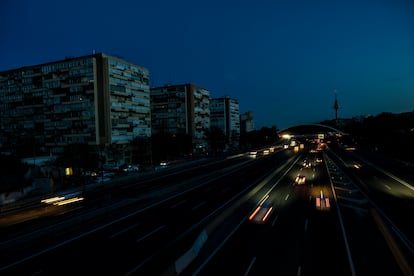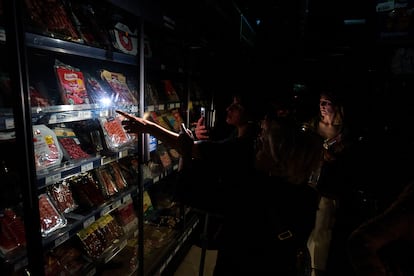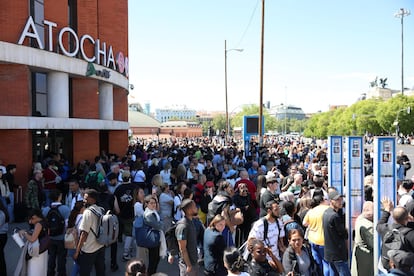Spain tries to go back to normal after biggest blackout in its history
More than 99% of the country’s power supply has been recovered, but some rail service is still suspended in Madrid and Barcelona

Spain was attempting Tuesday morning to return to normality after the country suffered the largest blackout in its history. At just after 12:30 p.m. on Monday, there was “a very sharp fluctuation in power flows” that caused a collapse across the entire power grid in the Iberian Peninsula, also affecting Portugal, according to the initial explanation provided by Red Eléctrica de España (REE), the electricity grid operator. By 6:00 a.m. on Tuesday, more than 99% of the country’s power supply had been restored and all substations in the network were back on line, the company reported.
The massive blackout caused major traffic disruptions on Monday, with rail services interrupted and traffic lights rendered inoperative. By Tuesday morning, high-speed and long-distance rail connections had returned to a large extent, and in the major cities the subways and commuter trains were attempting to return to their normal schedules. In Madrid, the Cercanías commuter trains were running at 50%, while in the northeastern region of Catalonia service remained suspended due to the instability of the electric service. Madrid’s subway service was fully restored by 8 a.m. Tuesday, regional authorities reported.
Prime Minister Pedro Sánchez has been meeting with the National Security Council, chaired by King Felipe VI, since 9:00 a.m. In a public appearance on Monday night, Sánchez stated that an investigation is underway into why electricity generation was “suddenly” lost at 12:33 p.m. on Monday. “It had never happened before,” he said. The Spanish Cabinet is also meeting on Tuesday to discuss the situation and the government’s actions.

At 12:32 p.m. on Monday, a fluctuation was detected in the electricity grids due to a loss of generation, that is, a drop in electricity production. The drop was caused by a five-second loss of 15 GW of generation (to get a sense of the magnitude, the five nuclear power plants in Spain have a combined installed capacity of 7.4 GW). The unprecedented collapse triggered the disconnection of the Spanish electricity system from the European system, which is based on an interconnection with France.
The challenge now is to restore all the services that were suspended on Monday, starting with transportation. On Monday, the only option for people who were stranded was to travel by bus, on foot, or by private transportation, although the General Directorate of Traffic advised against all non-essential travel. At airports, operating capacity was reduced by 20% and there were delays due to the difficulty some crews had in reaching their planes.

Given the obvious mobility difficulties caused by the blackout, the Labor Ministry issued a message of reassurance. The department headed by Deputy Prime Minister Yolanda Díaz reminded workers that when there are reasons beyond their control that prevent them from getting to work, the law provides for paid leave. However, many workplaces that were forced to send their employees home Monday were expected to operate normally on Tuesday. The Seat and Ford car factories are among those that have halted their production lines, as have other industrial complexes such as the petrochemical plant in Tarragona and the ArcelorMittal plants.
At street level, the halt in activity was most noticeable in small businesses. Many establishments chose to close their doors on Monday, while many that remained open generally required cash payments. Only a few banks’ credit card terminals allowed card use, although financial services generally operated normally, and the Ibex 35 stock exchange enjoyed a placid day.

Investigating the causes
The government has stated that all possible causes are still on the table, while REE reiterated the phenomenon that caused the grid failure: a power fluctuation in which 15 gigawatts of generation suddenly disappeared for a few seconds, although it did not clarify whether this was due to natural causes or if it could have been human action, whether intentional or not.
It will also be necessary to assess the economic damage of the blackout. This will vary by region, considering that in some areas the restoration of power took little more than an hour, while in others it took all day. By approximately 8:30 p.m., power was back in towns across all the regions, but unevenly. While some, like the Basque Country, had almost 100% of demand restored, in others it barely reached 15% at that time. The central government noted that the Military Emergency Unit (UME) has generators ready to deploy in areas where the power grid cannot be reactivated, if they should ever be needed.
The return to normalcy will also entail the return to political activity. The conservative European People’s Party congress is scheduled to begin Tuesday in Valencia. There are also some committees scheduled in the Spanish parliament, which closed its doors after the blackout. For hospitals, the shock will be lessened after they maintained basic services on Monday due to the generators that guarantee their operation. Some regions have announced that they will continue for the time being only with basic care. And Tuesday will likely be much calmer for security forces and emergency services, after a day in which they had to respond to thousands of calls and rescue numerous people trapped in elevators.
Sign up for our weekly newsletter to get more English-language news coverage from EL PAÍS USA Edition
Tu suscripción se está usando en otro dispositivo
¿Quieres añadir otro usuario a tu suscripción?
Si continúas leyendo en este dispositivo, no se podrá leer en el otro.
FlechaTu suscripción se está usando en otro dispositivo y solo puedes acceder a EL PAÍS desde un dispositivo a la vez.
Si quieres compartir tu cuenta, cambia tu suscripción a la modalidad Premium, así podrás añadir otro usuario. Cada uno accederá con su propia cuenta de email, lo que os permitirá personalizar vuestra experiencia en EL PAÍS.
¿Tienes una suscripción de empresa? Accede aquí para contratar más cuentas.
En el caso de no saber quién está usando tu cuenta, te recomendamos cambiar tu contraseña aquí.
Si decides continuar compartiendo tu cuenta, este mensaje se mostrará en tu dispositivo y en el de la otra persona que está usando tu cuenta de forma indefinida, afectando a tu experiencia de lectura. Puedes consultar aquí los términos y condiciones de la suscripción digital.
More information
Archived In
Últimas noticias
The metaverse, four years later: Is it finished or just at a standstill?
$3,000 and a plane ticket: The United States increases incentives for migrants to self-deport before the end of the year
Charles Dubouloz, mountaineering star, retires at 36 with a farewell tour inspired by Walter Bonatti
From the White House to diplomatic gifts: Lego wins over adult fans, brick by brick
Most viewed
- The low-cost creative revolution: How technology is making art accessible to everyone
- Christian Louboutin: ‘Young people don’t want to be like their parents. And if their parents wear sneakers, they’re going to look for something else’
- All the effects of gentrification in one corner of Mexico’s Colonia Roma
- Christmas loses its festive spirit: ICE fears cast shadow over religious celebrations
- Liset Menéndez de la Prida, neuroscientist: ‘It’s not normal to constantly seek pleasure; it’s important to be bored, to be calm’











































